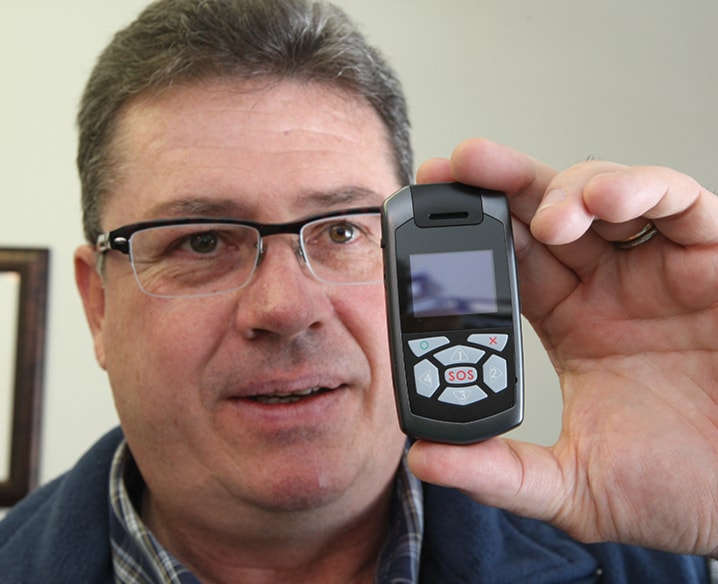Janet Smith woke up Monday night in a panic. She had just dreamt that her ex was attacking her and stabbing her in the neck, and she couldn’t breathe.
Now her biggest concern is that her nightmare may become reality.
On Tuesday at lunch, Smith, who’s real name is being withheld to protect her identity, received a phone call telling her that the Red Deer pilot program that helped keep her abusive former common-law husband away had come to an end.
They were part of the GPS Electronic Monitoring project that placed an ankle bracelet with a tracking device on convicted abusers who are under direct orders to avoid contact with their victims. If they were found to be in breach of those orders, the consequences would be swift and severe.
Smith is convinced it is the only thing that was keeping her safe.
“When they put the bracelet on, I felt at ease because I knew that the RCMP were watching him,” she said. “I even took the step of moving (out of town) and driving every day to Red Deer for work, but now I’m thinking I might have to quit my job.”
Smith’s ex was considered a high risk to re-offend and that was why he was fitted with the bracelet.
Before they were placed in the program, she had moved multiple times and he had always tracked her down.
While in the program, she did not have contact with her ex: the direct evidence the bracelet represents would lead to with harsh penalties that include jail time.
“He won’t breach those terms, but on a no-contact order he was constantly breaching it because there was no consequences,” Smith said.
Smith is aware of other women in the program who are now afraid for their safety.
At the height of the local pilot project, 13 bracelets were in use.
It was bankrolled for three years, at a total of $450,000, by the provincial government through the Alberta’s Safe Communities Innovation Fund, in co-operation with Alberta Justice, the RCMP and the Central Alberta Women’s Emergency Shelter Society.
However, funding ran out on March 31.
All of the data and results from the program have been sent to the University of Calgary for analysis. The results are expected back between June and August and it will be up to the provincial government to further fund the program in Red Deer and potentially take it Alberta-wide.
Similar pilots were run in Edmonton and Calgary and have been continued with other funding.
“The technology really does have very practical applications in domestic violence and law enforcement and community corrections,” said CAWES executive director Ian Wheeliker. “I don’t think it’s a question of if, it’s a question of when this will become standard procedure in dealing with domestic violence.”
But by that time, Smith is scared it will be too late.
“That’s a long time from now,” she said.
The biggest stumbling block is the price.
However, Wheeliker says the financing becomes more palatable the more bracelets are in use. Then, the price per unit drops, as does the cost of data for each unit.
Offenders like Smith’s ex wore the bracelets under court order as part of probation conditions.
Over the course of the program, the project became more efficient and the technology improved regularly.
Still, the bracelets did not completely prevent abusers from contacting their victims and going into no-go zones, like their victim’s workplace, their neighbourhood or their children’s schools. Where they did help was in response from the RCMP.
“We were able to respond directly to where the offender was at, eliminating a lot of the chasing and trying to locate the person,” said Insp. Karen Simon, adding they saw a big decrease in the number of breaches among offenders. “It gave you that evidence immediately if there was a breach of probation conditions.”
Simon, who has been involved with the program from the beginning in Red Deer, says the parameters surrounding the probation of each case remains the same, the only thing that has changed is there is no more bracelet.
She she said that each woman has been supplied with a safety plan tailored to their situation and they should lean heavily on it. Above all, however, they need to remain acutely aware of their surroundings and if they have any immediate concerns, they should contact the police.
And the women involved in the pilot program have been provided with a different GPS unit, the ST200. The ST200 is like a cellphone and is much more cost efficient at about $30 per device per month. All the victim has to do is press a button if they feel threatened, and regardless of where they are the RCMP will respond in a matter of minutes. The ankle bracelets only worked in Red Deer.
This program is funded through the Victims of Crime Fund.
Smith has had the hand-held device since they entered the system, but it was only with the ankle bracelet that she truly felt safe and was left undisturbed. The RCMP may have a quick response time, but it is the minutes before they get there that concerns her.
“He knows where I am now, and he can come here because there’s no red flags and there’s nothing stopping him from coming in the front door,” she said. “By the time I press that button, who knows? Right?”
jaldrich@www.reddeeradvocate.com
